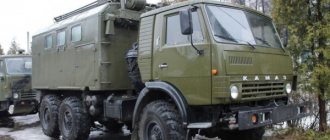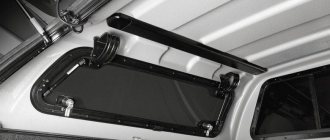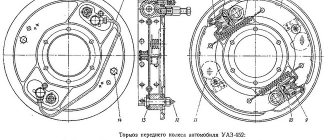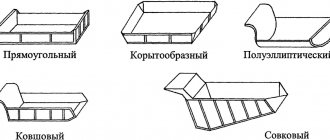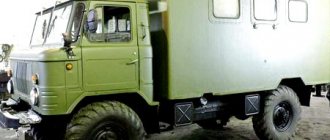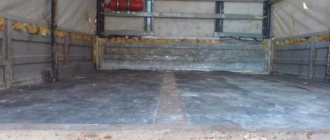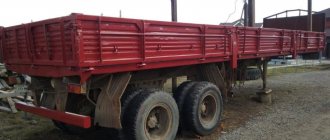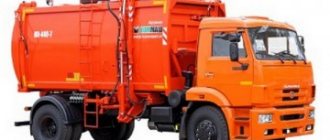What is KUNG? The history of the appearance of Universal Bodies of Zero (Normal) Dimensions
Maxim Shelepenkov
I hear this question quite often. At first glance, it is not difficult to answer. Today, any insulated booth on a car or trailer is called KUNG. You can also add that this is an abbreviation for Universal Body of Zero (Normal) Dimensions . Everything is clear and understandable, but if you delve a little into the history of this issue, it turns out... that we often call the wrong bodies KUNGs!
Sale trailer kung cabin
Chassis: MAZ-5224V Body: Kung Military purpose: low-load trailer for transporting equipment on any type of road Civil use: residential module, motor home, construction trailer Manufacturer: USSR, Minsk Automobile Plant Condition: preserved and stored Price: 180,000 rub.
To buy a kung cabin trailer with conservation and storage, send a request from the website or contact the telephone line. You can leave a request by phone 24 hours a day. Requests are processed during business hours.
Photos of trailers
Description and technical specifications
The KP-10 van body, or in common parlance a kung cabin , is often mounted on a chassis frame and used in civilian use. The use of kung cabins is more common on construction sites, industrial parking lots or in places for temporary residence and storage of goods and materials.
The MAZ-5224V trailer, made on the basis of a biaxial chassis, has a cargo platform design for placing various equipment and bodies. Designated 2-PN-10 – low-bed, two-axle automobile trailer with a loading platform.
Kungs with power supply systems and diesel power plants are mounted on a universal frame.
Source
Background
Before you find out what a real KUNG is, you need to understand the definition of zero (normal) size, encrypted in its name. At the end of the 1940s, a need arose to bring the dimensions of PARM-type automobile bodies to one size in order to make them easily transportable, primarily on European railways. Why European and not domestic? Firstly, our presence in the countries of Eastern Europe after the victory over fascism was completely natural. And secondly, the Russian railway gauge (1520 mm) is considered wide throughout the world, therefore, the domestic 1T gauge was completely unsuitable for universal typology, but the Polish-German railway standard, which was listed in the “Agreement on International Rail Freight Traffic” as “Gauge loading on 1435 mm gauge railways”, fully reflected the standards of pan-European gauge. This standard corresponds to our size 02-T (02-VM), from the first digit of which it became known as “zero size”, and this term is the most accurate. And since the “Stephenson” gauge (1435 mm) was called “normal gauge” back in the Soviet technical encyclopedia of 1931, the “zero” gauge is sometimes called “normal gauge”. This is where two interpretations of the abbreviation KUNG come from.
KUNG-1M and KUNG-P2M
But the first army car bodies, standardized to “zero size”, were not yet real KUNGs. At that time, they were developed by various design organizations for the army, and were produced by small woodworking factories. As a rule, outdated technologies were used in the manufacture of bodies that were not intended for mass production. What was needed were standard bodies of a new type, suitable for industrial production in large quantities. The first steps in this direction were taken at the beginning of 1950, at the 38th Experimental Military Plant in Bronnitsy, where six types of unified wood-metal van bodies were developed: “SN”, “SV”, “SUN”, “SUV”, “MN” and "MV". After manufacturing and testing all the experimental vans, only one was chosen for mass production - the “CH” type (medium low). It was intended for installation on ZiS-150 and ZiS-151 vehicles (we wrote earlier about the VAREM workshop located in this body). But the “SN” body can hardly be called universal, equally suitable for accommodating various army equipment, a mobile hospital, and a headquarters radio station. It was necessary to develop new universal bodies.
K66U1D
Price list
Relevance as of September 16, 2021
The price list and the RosReservy website displays basic prices. The price may be changed during the order approval process depending on the configuration, additional service, delivery, condition, re-equipment of individual equipment, etc.
Equipment, machines, property and warehouse remains from conservation and storage have all the permitting documentation for circulation in the civil legal field. Cars and trucks are supplied with a title, self-propelled vehicles with a vehicle registration certificate, or a package of documents for submission to the State Traffic Inspectorate or Gostekhnadzor.
Not KUNG at all. Part 1
We have already found out that the army bodies produced in the 50s had many shortcomings. On instructions from the State Planning Committee of the USSR and the Ministry of Defense, specialized design organizations began designing interchangeable and outwardly almost indistinguishable van bodies: with a metal frame of the “KM” type and a frameless structure made of reinforced foam plastic panels of the “K” type. Frame bodies were developed by the design bureau of the Moscow Body Plant, panel bodies were developed by the design bureau of the 38th Experimental Plant of the Moscow Region.
According to the project, the main type of van body 38 OPP MO was developed in 1958–1960. The series included the following products: K66 - for the then promising GAZ-66-02, K66U1D for the ZIL-157, K66U1 - for the ZIL-131, K66U2 - for the ZIL-130, K66U7 - for trailers. The numbers indicate the chassis for which the body was originally designed, but modified bodies of the K66 series were initially installed on all ZIL vehicles and two-axle trailers. Unlike wood-metal bodies, they were equipped with a standard heating and ventilation system. The design of the panels and assembly with riveted seams ensured the required strength and tightness of the products, and their weight was significantly reduced.
K66N
K66 new
From the Central Design Bureau in 1963, in the process of reorganization, the All-Union Design and Technological Institute of Furniture (VPKTIM) was formed, which in December 1966, by Decree of the Council of Ministers of the USSR No. 1010-325 of December 13, 1966, was assigned responsibility for the implementation of a unified technical policy in organization of the production of van bodies of the “K” and “KUNG” types, and by the decision of the Military Industrial Commission of February 15, 1967 No. 28, the Resolution of the Central Committee of the CPSU and the Council of Ministers of the USSR of January 16, 1967 No. 37-10 and the order of the USSR Ministry of Forestry of February 24 .67 VPKTIM was appointed as the leading institute for reinforced foam van bodies. Meanwhile, the State Planning Committee was looking for free capacity in industry to produce new products. At the suggestion of the Chuvash Economic Council, the Shumerlinsky Furniture Plant, which has already proven itself well in the production of KUNG-type van bodies, was chosen as the manufacturer. Already in 1961, the plant was given a plan to produce 30 van bodies made of reinforced foam plastic, in 1962 - 71 bodies, in 1963 - 234. In 1962, the Shumerlinsky plant received documentation for the chassis from UralAZ and the plant was charged with producing a panel body for the Ural-375A car. In July 1962, the first K-375 body was assembled at the plant. By the end of the year, 8 more K-375 bodies were produced (3 for the Ural-375B chassis and 5 for the Ural-375A).
K4320
K4320
Despite the fact that new bodies had been manufactured in Shumerla for several years and even mastered production of a new model (K 375), it was only in 1964 that decree of the CPSU Central Committee and the USSR Council of Ministers No. type made of reinforced foam. After this, the plant began construction of a complex of structures for organizing the mass production of K-type bodies. In the meantime, while the plant was being reconstructed, the production of panel vans was organized at the existing production facilities. That is why in 1967 the plant’s plan to produce KUNG-type bodies was withdrawn. New workshops at the DOK came into operation in 1972, and since 1975 it was renamed the “Sumerlinsky Automobile Van Plant”.
In addition to the Shumerlinsky plant, new enterprises gradually joined the production of K-type bodies: since 1965 - the Gomel DOK, since 1970 - the Kozlovsky plant in the Chuvash Autonomous Soviet Socialist Republic, in 1973 - the Krasnogorsk plant in the Mari Autonomous Soviet Socialist Republic and the Krasno-Pakhorsky repair plant. At the suggestion of the Shumerlinsky plant, body factories were specialized according to the types of bodies produced. Gomel DOK got the production of bodies for GAZ 66 cars, Kozlovsky and Krasnogorsky - for Ural cars, and Krasno Pakhorsky and Shumerlinsky - for ZIL cars, later Shumerlinsky also got KamAZ.
K4310
Click on the desired item to expand the list
Power plants and generators
| Name | Price |
| AD-16-T400 | 45 000 |
| AD-30-T400 | 180 000 |
| AD-60-T400 | 430 000 |
| AD-100-T400 | 490 000 |
| AD-200-T400 | 890 000 |
| ED-500 T | on request |
| DGU 1000 | on request |
| FG Wilson P1250 | on request |
| Power plant PAES-2500 | on request |
| Power plant PGRES-5 | on request |
Engines YaMZ KamAZ ZIL UTD
Engine quality
We offer storage and conservation engines for delivery, nominal shaft Engines are numbered, accompanied by proper documentation Full pre-sale preparation has been carried out - inspection, replacement of rubber goods, etc.
Quality control
Each engine undergoes bench testing before shipment Full pre-sale preparation is carried out Motors are ready for installation on equipment and commissioning
Guarantees
Delivery under the Contract, 1 year warranty, seals, documents
Delivery
Delivery to regions, loading onto transport or into transport centers in Russia and the CIS is carried out by agreement
Engine year
New-style engines have been produced at YaMZ (Avtodiesel PJSC), TMZ, KamAZ plants since 2010. If you require old-style factory engines, please indicate this in your request
Source
Not KUNG at all. Part 3
But what about the frame-metal (welded) bodies of the KM series, the attentive reader will ask? Their development and production proceeded according to their own laws. The mass production of these bodies was first undertaken by the Moscow Automobile Body Plant (we talked about this plant in “GP” No. 5, 2007) and the Engel Special Vehicles Plant, and later the Kozelsky Mechanical Plant joined them. The first in this series appeared the KM-500V body for the Ural-375 (1961), since 1964 in Moscow they began to mass-produce the KM 66 body for the ZIL-157, later the KM-131 for the ZIL-131 and KM-500 for the chassis MAZ-500. In 1970, KM-66 vans for GAZ-66 were mastered in Kozelsk, and in 1977, production of KM-500V bodies for Ural vehicles began there. Since 1980, a plant in Saransk was connected to the production of KM bodies for KamAZ, which developed an extended modification of the KM-500 body. All KM vans had a metal welded body frame, the steel floor was covered with plywood from the inside, the internal lining of the walls and ceiling was made of fiberboard, and the insulation was polyurethane foam.
It turns out that the army vans of the “K” and “KM” series have become the most popular and familiar to us. It is these that we commonly call today KUNGs. Everyone is so accustomed to this that one article in a magazine cannot change anything in this situation. The main thing is that you and I now know exactly what real KUNG is!
KUNG-4310
Source https://www.gruzovikpress.ru/
